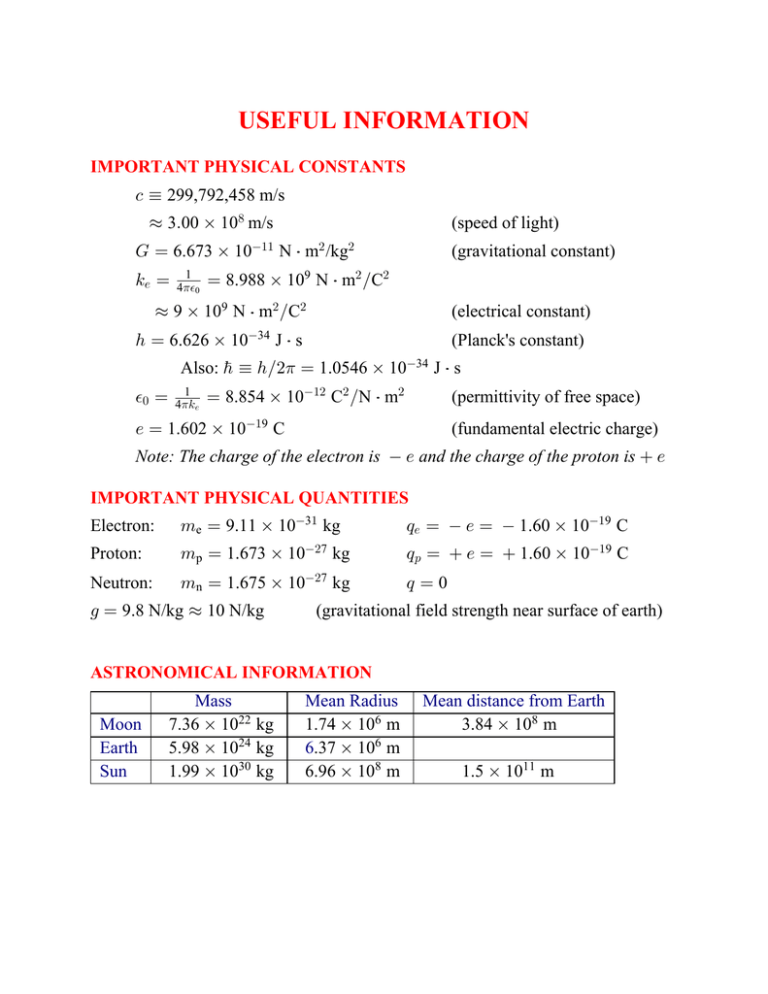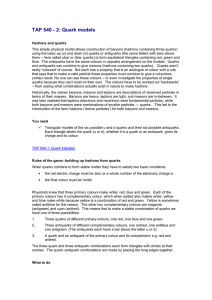USEFUL INFORMATION
advertisement

USEFUL INFORMATION IMPORTANT PHYSICAL CONSTANTS - ´ 299,792,458 m/s ¸ 3Þ00 ‚ 10) m/s (speed of light) K œ 6.673 ‚ 10"" N † m# /kg# 5/ œ 1 41%0 (gravitational constant) œ 8.988 ‚ 109 N † m# ÎC# ¸ 9 ‚ 109 N † m# ÎC# (electrical constant) 2 œ 6.626 ‚ 1034 J † s (Planck's constant) Also: h ´ 2Î#1 œ 1.0546 ‚ 1034 J † s %! œ 1 415/ œ 8.854 ‚ 10"# C# ÎN † m# (permittivity of free space) / œ 1.602 ‚ 10"9 C (fundamental electric charge) Note: The charge of the electron is / and the charge of the proton is / IMPORTANT PHYSICAL QUANTITIES Electron: 7e œ 9.11 ‚ 103" kg ;/ œ / œ 1.60 ‚ 10"9 C Proton: 7p œ 1.673 ‚ 10#7 kg ;: œ / œ 1.60 ‚ 10"9 C Neutron: 7n œ 1.675 ‚ 10#7 kg ;œ0 1 œ 9.8 N/kg ¸ 10 N/kg (gravitational field strength near surface of earth) ASTRONOMICAL INFORMATION Moon Earth Sun Mass 7.36 ‚ 1022 kg 5.98 ‚ 1024 kg 1.99 ‚ 1030 kg Mean Radius 1.74 ‚ 106 m 6.37 ‚ 106 m 6.96 ‚ 108 m Mean distance from Earth 3.84 ‚ 108 m 1.5 ‚ 1011 m SI ("SYSTÈME INTERNATIONALE) UNITS The fundamental units of the "metric system" are: ç ç ç ç the kilogram (kg) for mass, the second (s) for time, the meter (m) for length, and the ampere (A) for electric current. In addition to the basic units of SI, multiples and submultiples can be formed used metric prefixes such as M (for mega) for 1,000,000 or . (for micron) for 0.000001. The prefixes and their symbols are listed below. The most common ones, the ones you should know, are given in boldface. atto (a) œ 1018 nano (n) œ 109 centi (c) œ 102 exa (E) œ 1018 giga (G) œ 109 hecto (h) œ 102 femto (f) œ 1015 micro (.) œ 106 deci (d) œ 101 peta (P) œ 1015 mega (M) œ 106 deka (da) œ 101 pico (p) œ 1012 milli (m) œ 103 tera (T) œ 1012 kilo (k) œ 103 Some combinations of the basic units are important enough to have their own SI names and symbols. These are referred to as major derived units. For future references, here are some of the major derived units that we will encounter in Physics 112: MAJOR DERIVED UNITS Electric charge: Energy: Force: Power: the coulomb (C) the joule (J) the newton (N) the watt (W) 1Cœ1As 1 J œ 1 kg m2 s2 1 N œ 1 kg m s2 1 W œ 1 kg m2 s3 IMPORTANT CONVERSION FACTORS 1 inch œ 2.54 cm (exact) 1 foot œ 12 inches œ 30.48 cm (exact) œ 0.3048 m (exact) 1 mile œ 5280 feet œ 1.609 km œ 1609 m 1 cal (calorie) œ 4.186 J (1 Calorie or "food calorie" œ 1 kcal œ 4186 J) 1 Btu (British thermal unit) œ 1055 J The "weight" or gravitational force at the earth's surface on a 1-kg mass is 2.205 pounds. 1 eV œ 1.6 ‚ 10"9 J (electron-volt, an important unit of energy) THE ELECTROMAGNETIC SPECTRUM This table shows the range of wavelengths, frequencies, and photon energies associated with the different parts of the electromagnetic spectrum: Type of wave Wavelength Frequency (Hz) Photon energy (J) Radio 100 mm 3 ‚ 109 2 ‚ 1024 Microwave 1 100 mm 3 ‚ 109 3 ‚ 1011 2 ‚ 1024 2 ‚ 1022 Infrared 0.7 1000 .m 3 ‚ 109 3 ‚ 1011 2 ‚ 102# 3 ‚ 10"* Optical 400 700 nm 3 ‚ 109 3 ‚ 1011 3 ‚ 1019 5 ‚ 1019 Ultraviolet 10 400 nm 3 ‚ 109 3 ‚ 1011 5 ‚ 1019 2 ‚ 1017 X-ray 0.01 10 nm 3 ‚ 109 3 ‚ 1011 2 ‚ 1017 2 ‚ 1014 Gamma-ray 1011 m 3 ‚ 1019 2 ‚ 1014 This diagram shows the visible or optical part of the electromagnetic spectrum from high energy to low energy: Colors of the visible or optical spectrum, from short wavelength to long wavelength: violet, indigo, blue, green, yellow, orange, red. MATHEMATICAL NOTATION Physics is a quantitative subject which relies heavily on mathematics. It is important to use consistent mathematical notation. || Denotes the absolute value of a scalar or the magnitude of a vector. ´ Denotes a definition. œ Denotes equality in several different ways. For example, E œ F would mean that the variables E and F are equal to one another in some specific situation, though probably not in general, while E œ 14 m would mean that E equals 14 m in some specific situtation. ¸ Read as “approximately.” Normally used in estimation, to indicate an approximate value that is adequate for most calculations. Typographical rules: • Italic fonts are used for variables, like Bß Cß Dß 7ß X ß +tß Jt ß and >Þ They are not used for the symbols for units. • The symbols for units are written upright: the symbol for meter is “m” rather than “7” and the symbol for gram is “g” not “1.” • Thus “Mm” represents megameter while “Q 7” might be the produce of two masses, Q and 7. Similarly “kg” is kilogram while “51” is the product of two variables denoted by “5 ” and by “1.” • A vector quantity is denoted by an arrow above the symbol for the vector, for example, Et or Jt . The magnitude of the vector is denoted in one of two ways: • Using the same symbol without the arrow: E is the magnitude of the vector Et • Using | |: The magnitude of the vector Et can be denoted |Et|. MATTER PARTICLES LEPTONS Leptons & their electric charges / // . /. 7 /7 / 0 Antileptons & their electric charges / q // . q /. 7 q /7 / 0 Names: Names: electron, muon, and tauon electron's , muon's, and tauon's neutrino antielectron (positron), antimuon, antitauon electron's, muon's, and tauon's antineutrino The only lepton occurring in common everyday matter is the electron. QUARKS Quarks and their electric charges ? . = > , 2//3 //3 Antiquarks & their electric charges q ? q . q q = q > q , 2//3 //3 Names: Names: up quark, charmed quark, top quark down quark, strange quark, bottom quark up, charmed, and top antiquarks down, strange, and bottom antiquarks Each of the six quarks comes in three varieties (or "colors"), called Red, Green, and Blue. Each of the six quarks comes in three varieties (or colors), called Antired, Antigreen, and Antiblue. Composite particles consisting of quarks are called hadrons. All hadrons are "colorless" so they must have either three quarks, including one quark of each color, or a quark and an antiquark of the proper anticolor. Three quark hadrons are called baryons, and quark-antiquark hadrons are called mesons. The only quarks occurring in common everyday matter are the up and down quarks. The neutron consists of one up and two down quarks, and thus has zero electric charge, while the proton consists of two up and one down quarks, and thus has electric charge /.









